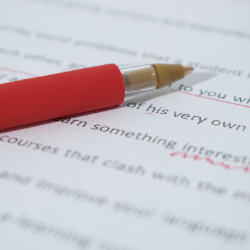 It doesn’t matter if you’re the author of a short blog post, an online or print publication, or a lengthy technical paper – there are fundamental writing guidelines that must be followed to maintain credibility and integrity.
It doesn’t matter if you’re the author of a short blog post, an online or print publication, or a lengthy technical paper – there are fundamental writing guidelines that must be followed to maintain credibility and integrity.
From citing to quotations, to authorship and beyond, it is clear that author mistakes extend beyond plagiarism. As an organization that not only accepts, but advocates, academic and theoretical writing, IEEE Computer Society has established best practices to identify and combat common author mistakes.
Widespread errors include referencing, authorship, submission, and plagiarism. Although seemingly small and inconsequential, an oversight can ultimately lead to irreversible damage to your organization, reputation, and beyond.
We want to assist you with avoiding these common pitfalls. Please review the 5 most frequent mistakes we see amongst submissions at the Computer Society and review your next piece of work carefully, to avoid the following.
Interested in sharing your research? Access our Publishing Guide!
The Mistake: Lacking Reference to Used Material from Another Author’s Work
The Solution: Reference the author and their work, every single time you apply one of their sentences, paragraphs, or thoughts. This applies to copying a full article or a major portion of an article without quotation marks, credit notice, reference, and bibliography.
Paragraphs, sentences, illustrations, and all other individual elements should be properly credited. Improperly paraphrasing pages or paragraphs (instances of improper paraphrasing occur when only a few words and phrases have been changed or when the original sentence order has been rearranged; no credit notice or reference appears with the text) should be immediately resolved.
If you’re quoting the same author more than once, but are referencing multiple pieces of work, you must properly credit each article.
As a general rule of thumb, reference everything you borrow for your article, blog post, or publication. Failing to give credit where credit is due is one of (if not) the most common mistakes an author makes.
The Mistake: Lack of Clear Quotation Marks around Reused Material That Has Been Referenced
The Solution: Credit with clear delineation. Instances could include sections of an original article copied from another article; credit notice is used but the absence of quotation marks or offset text does not clearly reference or identify the specific, copied material.
Without clearly identifying the material you are referencing within your piece of work, the reader may not be able to distinguish where the thoughts and messaging derive from.
Ultimately, the author of the content that you are quoting may not receive credit for their contribution to your piece of literature, which is necessary within the context of publishing.
The Mistake: Multiple Publications or Submissions
The Solution: If you need to republish your work, you must annotate the content as being republished, as well as indicating how the new submission differs from your previously published work.
This is especially important if you are an academic or expert being published (or in this case – republished) within a library of peer-reviewed publications. As necessary, publication libraries may even require permission.
The IEEE Computer Society’s requirements for reusing previously published material cover a variety of reasons including serving readers by aggregating special material in a single publication. When such a republication occurs, the original publication venue should be provided as a special note on the front page of the article.
This is not as much of a mistake as it is a decision. Deciding to republish your work should be taken up with the library or blog you plan to publish it on or in.
The Mistake: High Number of References to the Author’s Own Work
The Solution: Only those articles of a researcher’s publication record that are directly relevant to the subject matter of the article under consideration should be included in the bibliography.
Publishing an article is not your opportunity to reference every past piece of original work. Of course, it is a wonderful opportunity to apply past research or experience to your new content – but this should only be the case if your past work applies to your current work.
Not only can plugging your own (irrelevant) content come across as a bit smug, but it can also become problematic when attempting to publish within specific libraries, such as ours.
IEEE Computer Society considers it an error and will request that unnecessary subject matter be removed from the submitted piece of work.
The Mistake: Listing Too Many or Too Few People as Authors
The Solution: Authorship and co-authorship should be based on a substantial intellectual contribution. Publications assume that all authors have had a significant role in the creation of an article that bears their names.
Simply put, add the names of those who had a significant role in the creation and finalization of the content. Including an uninvolved or excluding an involved author is absolutely frowned upon within all journals and libraries, and should never be submitted.
As you can see, from citing to quotations, to authorship and beyond, it is clear that author mistakes extend beyond plagiarism. The above mistakes and solutions apply directly to any submission within our organization, and the majority apply to any prospective journal or library.
Now is the time to avoid any seemingly small and inconsequential oversight, as it can ultimately lead to irreversible damage to your organization, reputation, and beyond.
Those of us at IEEE Computer Society wish you luck with wherever and whenever you decide to submit your work, and hope that by acknowledging these frequent and common pitfalls, you are able to publish an article that you are fully confident in and proud of.